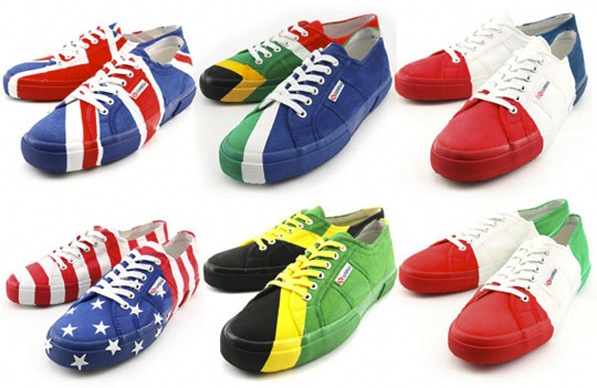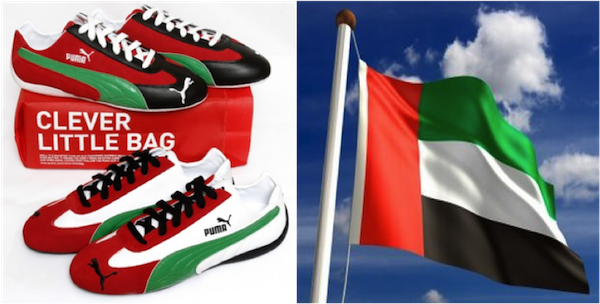English version of La maladresse interculturelle de Puma – many thanks to Anne Kingsland for the translation.
A marketing blunder
On 2nd December last, the federation of United Arab Emirates (UAE) celebrated the fortieth anniversary of its birth. On this occasion, the equipment manufacturer Puma had the idea to create a special model of sports shoes taking up the colours of the flag of the UAE (see above).
The launching of this model in the Emirates stores immediately provoked a wave of indignation, which forced Puma to withdraw it from the market and publish a statement to apologize. Here is an extract from this statement:
“The shoe was never intended to upset or offend our customers here in the Middle East, but to give the people of the UAE a piece of locally created design as a symbol of recognition of this great occasion.”
The reaction of an Emirates media specialist, Aida Al Busaidy, is particularly interesting:
“A national flag represents a country and what it stands for and it is strictly not right for depicting it on shoes or anything that is worn on the feet. It is highly disrespectful?”
This indignant reaction seems strange to us in the West. Indeed, many brands of shoes incorporate the colours and patterns of national flags, especially for special occasions. For instance, during the football World Cup of 2010, the brand Superga had released six models with the flags of the United Kingdom, South Africa, France, the United States, Jamaica and Italy: 
Yet, if in some countries it is acceptable to reproduce the national flag on shoes, it is not the case elsewhere. According to Aida Al Busaidy, Puma officials have not understood anything of the local culture:
“They really need to understand a nation’s cultural values. On what basis did they decide to use these colours. Did they conduct any research and speak to any of the Emirati population to find out if it was okay to place the flag on the shoes?” she said adding that the practice might be acceptable to other nationals in Europe or elsewhere but it is definitely not here. “May be the Italians are okay with it. But we are not,” she added.
The shoe: from insult to revolution
If the Emiratis felt offended by the model designed by Puma, it is because the shoe does not have the same status in Arab countries as in Western countries. The shoe is actually in contact with two impurities: the ground with dirt and filth, and the foot that every Muslim must wash before prayer. It is unthinkable to enter a mosque with your shoes on your feet, alternatively the shoes must be held in your hand sole against sole.
It is extremely rude to show the soles of your shoes to your interlocutor. A Wikileaks cable revealed that during his visit to Morocco in October 2007, Nicolas Sarkozy inadvertently offended his hosts. While he was sitting next to Mohammed VI, he crossed a leg, directing the sole of his shoe towards the king. Here is an extract from the report by the Americans:
While Sarkozy was generally well received, there was much gossip in Moroccan salons about a “too relaxed” President slouching comfortably in his chair as he and the King presided over an October 22 signing ceremony at the Royal Palace in Marrakech. In one image, Sarkozy was seen crossing his legs and pointing the sole of his shoe at the King – a taboo gesture in the Islamic world.
See the picture below. Even if the desk is hiding the two Heads of State, we can see that Nicolas Sarkozy is showing the sole of his shoe to Mohammed VI:

Hence the throwing of a shoe as the ultimate insult and expression of revolt. Everyone remembers the press conference in December 2008 when George Bush had avoided the shoe of an angry Iraqi:
Since then, this gesture has been imitated many times. A Wikipedia page is even devoted to this in order to list the dozens of cases of shoe throwing against the authorities of the Arab and Muslim world. In Tikrit in Iraq, a shoe-shaped monument was erected in tribute to the Iraqi gesture against George Bush:

More recently, the Arab revolutions have led to huge gatherings in which the act of brandishing one’s shoe was an expression of anger against the powers that be:

The cultural gap between the West and the Middle East
More generally, the gaffe by Puma is part of a cultural gap between the West and the Middle East. Puma has retained the idea that the sports shoe was a vector of identity, the sign that one belongs to a group and supports the values of this group. In all logic, the manufacturer concluded that nothing could better illustrate this identity, this belonging and these values than the national flag.
In other words, Puma made the mistake of concentrating on the symbolic value carried by the shoe, and of overlooking the fact that the “shoe” as an object could also be the support of symbolic meanings, including negative ones.
Puma’s premise is that the shoe, and in this case the sports shoe, is necessarily a positive symbol (performance, efficiency, originality, distinction). This positive side has a story – which I have already mentioned in the article Entreprises et influence culturelle : les origines (Business and cultural influence: the origins). I would just repeat that the explosion in the sale of sports shoes in the 80’s is inseparable from the emergence of the rap industry.
The year of that explosion is very clearly identified. It is the year 1986 with the hit My Adidas by the rap band Run DMC. That year, the band had invited the top management of Adidas to one of their concerts: when they were about to sing My Adidas, they asked those wearing them to show one of their Adidas shoes… and twenty thousand shoes were waived in the air. Run DMC went on to be the first rap band to sign a sponsorship deal worth one million dollar with Adidas, who previously signed contracts with athletes.
From then on each rap band claimed a brand or a particular type of sports shoes. Backed up by a whole industry of music and clothing, rallying sign of rap bands, supporting fashion wear, carrier of behavioural norms and identity values, a distinguishing feature to stand out from adults, an object of desire, of collection or even of worship, the sports shoe became the symbol of American youth, then of European youth, and finally just of youth.
But this wave finds cultural obstacles in its path. It is the case with the Arab countries where the shoe is inseparable from the notion of impurity. Hence the ignorance of a cultural gap that has led to the gaffe by Puma.

Quelques suggestions de lecture:
- La maladresse interculturelle de Puma
- Working with the French – feedback from the field
- Manager dans la singularité – Entretiens de l’INSEP
- When details are monumental – 4 cross-cultural edifying stories
- Education systems, essential keys to understanding cultural differences
- In the Land of Equality – A Frenchwoman Shares Her Finnish Experience


Derniers commentaires